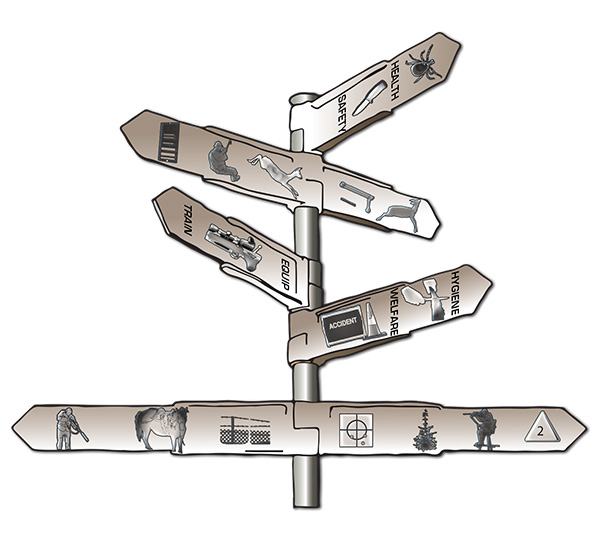
Aim
The aim of this guide is to
- provide guidance on key areas of assessment against BP, covering practical deer management activities
- outline a process of evidence gathering to support deer managers in identifying learning and skills needs
- provide guidance in identifying:
- procedures/equipment
- regulations
- training environments
- training opportunities/certification
- training providers
funding sources
- assess the ability of staff to follow BP guidance.
Introduction
The ability of a landholding/individual to follow BP guidance would depend on levels of knowledge and training, and identification of methods to fill any skills gaps.
Assessment would be undertaken using evidence such as:
- relevant training
- relevant training certification
- appropriate equipment
- procedures
- staff guidance and policies
- codes of conduct.
It is important to emphasise that the assessment is an information gathering exercise and does not seek to test the competence of individuals.
Roles and responsibilities
Owner/Responsible Person/Deer Manager
- To carry out assessment of Deer Management Activities on owned and managed land
- To report findings of assessment to owner/ senior management/responsible person
- To identify gaps where relevant WDBP guidance is not being met
- To recommend actions for improvement
Land Manager/Deer Manager
- To provide the relevant information and identify areas for action
- To facilitate an on-site practical assessment where appropriate
- To implement recommended actions as approved by Owner/Responsible Person*
Key Areas of Assessment with Supporting Evidence and Relevant Best Practice Guidance
| Key Areas | Evidence | Relevant WDBPG Guidance |
| Public Safety | DMQ (or equivalent) Public information |
Firearms safety Public access Public access signage |
| Food Safety | Compliance with Meat Hygiene Regulations. ‘Trained Hunter’ certification. Carcass tagging & Traceability Procedures. Appropriate equipment availability. SQWV. |
Carcass inspection (Notifiable diseases and Deer health) Supply of venison Basic hygiene principles Shot placement Gralloching & Extraction Lardering Larder hygiene & waste disposal |
| Welfare (Including Dispatch of Wounded Animals) | Wounded animal procedures. FCS Break-in Guidance Firearms shooting test. Codes of Practice. |
Welfare: definition and assessment. Welfare: culling. Use of helicopters: safeguarding welfare. Shot placement. Humane Dispatch. Reaction to shot & follow up. Use of dogs. |
| Training & Continuing Professional Development | Formal education (HNC, Nat Cert) DMQ certificates (or equivalent). SNH Fit & Competent Register WDBP Guidance: subscription and events. Relevant short courses. |
Training |
| Health & Safety (Including PPE) | Equipment checklist. First aid training. Radio procedures. |
Risk assessment. Health & safety. Lone working. Lyme disease. High seats. |
| Firearms | FACs. Rifle Check Certificates. |
Firearms safety. Maintenance and zeroing. Rifles and ammunition. Marksmanship. Security, transport & storage. |
| Carcass Handling & Extraction | Certificates (Drivers licence, argo, quad, winches, manual handling). Equipment checklist |
Mechanical & manual extraction. Pony extraction. Handling exceptional numbers of carcasses. |
| Larders and Venison | Equipment checklist. Venison Dealers Licence. SQWV. DMQ. Local Authority Documentation Larder records |
Larder hygiene & waste. Lardering. Skinning Butchering Supply of venison. Larder design. |
| Deer Management Planning | Deer Management Plan. Deer count data. Cull records. |
Deer Management Plans. Planning for biodiversity. Setting cull targets. Population assessment: open range counting. Population assessment: dung counting. Cull records. |
| Monitoring | Deer Management Plan. HIA data. |
Habitat Impact Assessment: principles. Habitat Impact Assessment: principles in practice. HIA: analysis. Woodland Damage: recognition of cause. |
| Socio-Economics | Stalking leases/contracts | Working with clients. Letting stalking. |
| Collaboration | Supporting DMG | Deer Management Groups. Team culling. Handling exceptional numbers of carcasses. |
*See Support for further guidance towards solutions for identified skills gaps
